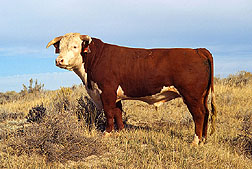This page has been archived and is being provided for reference purposes only. The page is no longer being updated, and therefore, links on the page may be invalid.
Researchers Help Cattle Breeders Optimize Profit and Desired Beef TraitsBy Kathryn Barry StelljesDecember 9, 1999 Tender steaks start with cattle breeders who carefully document numerous characteristics of their animals. They use this information to breed those animals with the “best” combination of desired traits. However, “best” has been a subjective and inconsistent measure, according to Agricultural Research Service geneticist Michael MacNeil. That slowed producers’ ability to breed improved animals. Now, thanks to ARS research, breeders may refine their decision-making by focusing on profitability. MacNeil works at ARS’ Fort Keogh Livestock and Range Research Laboratory in Miles City, Mont. ARS is the chief scientific agency of the U.S. Department of Agriculture. To assess their animals, breeders keep track of growth traits, such as weights at birth, weaning, and yearling ages and at maturity. They also measure carcass traits such as marbling and fat content that are indicators of value to consumers. In addition, they record traits like the age when a female reaches puberty, and her pregnancy rate. Breed associations take the information, combine it with each animal's genetic tree and run it through a computer program to develop an expected progeny difference, or EPD. That lets breeders compare individual animals for individual traits. They would know, for example, that cow A was more likely to produce offspring with the desired marbling than cow B. But the process is not complete. Producers were left with the difficult task of combining the EPDs in an efficient manner. So MacNeil is improving the performance testing process by using the EPDs to predict genetic potential for profit. With his system, breeders will be able to know how to trade off changes in fat thickness and marbling, for example, most profitably. Breeders would also be able to rank animals more effectively. If there were 100 bulls for sale, breeders could rank them numerically to find the best bull for their purposes. The complicated calculations are not yet available in a simple computer program for individuals to use. Producers will most likely get the information through Cooperative Extension Service specialists or breed associations as the lab passes on the technology. This research is reported in the December issue of Agricultural Research magazine. Click here to read about it online. Scientific contact: Michael D. MacNeil, ARS Fort Keogh Livestock and Range Research Laboratory, Miles City, Mont., phone (406) 232-8213, fax (406) 232-8209, mike@larrl.ars.usda.gov. |

